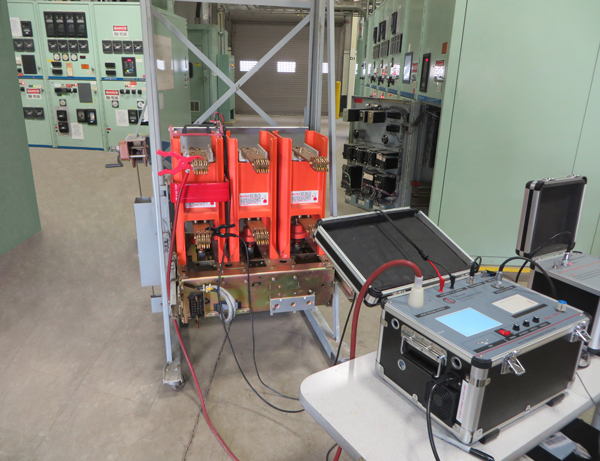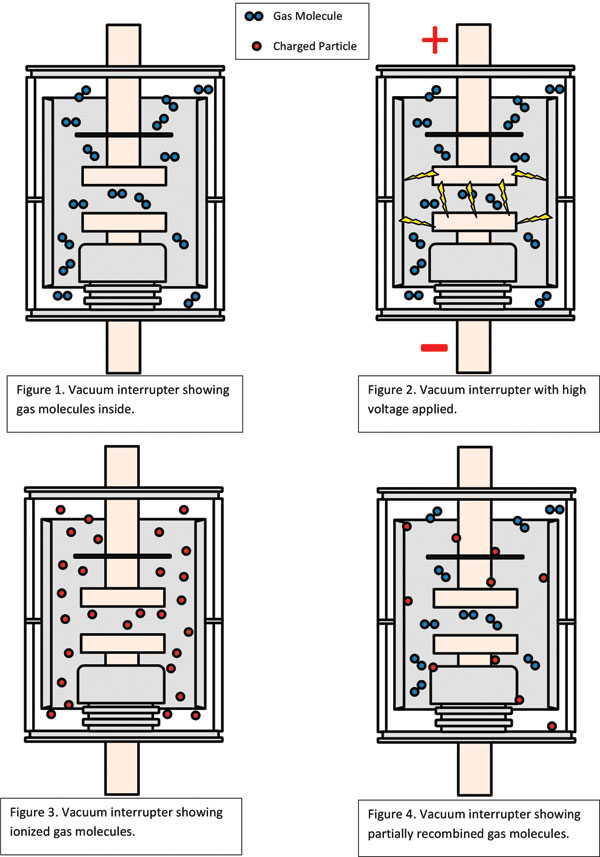MAC-TS4 Vacuum Interrupter Tester
Circuit Breaker Sales & Repair provides the MAC-TS4 vacuum interrupter tester, the third generation test set using patented technology for determining the condition of vacuum interrupters in the field, shop or laboratory.
New Technology – Better Results: Not a simple Go/No-Go ac high potential test, Magnetron Atmospheric Condition (MAC) vacuum interrupter test equipment predicts the usable life of a vacuum interrupter.
 Vacuum Interrupter Tester Set
Vacuum Interrupter Tester Set
Until now, the accepted field service test for vacuum interrupters has been a simple Go/No-Go test performed with an AC high potential test. Today, testing with the Magnetic Atmospheric Condition (MAC) test sets can prevent unnecessary damage to your circuit breakers and contactors by predicting the usable life of the vacuum interrupter.
Utilizing the Penning Discharge Principal, the MAC-TS4 vacuum interrupter test set can easily determine the pressure inside a vacuum interrupter and; along with wear and number of operations, predict the usable life of the vacuum interrupters used in your circuit breakers and contactors. Until now, this type of testing could only be done at the assembly plant.
Magnetic Field Test Coils
Flexible magnetic field coils are available for testing vacuum interrupters while installed in switchgear and magnetic field coil test fixtures are available for testing when removed.
Our unique, patented flexible magnetic field test coil enables vacuum bottle interrupters to be tested in-place, while installed in your circuit breaker or contactor. The flexible magnetic field coil is available in various lengths to accommodate most applications, and is used in conjunction with the MAC-TS4 vacuum bottle – interrupter tester.
For testing of individual vacuum interrupters that have been removed from a circuit breaker or contactor, a magnetic field coil test fixture is used in conjunction with the MAC-TS4 vacuum interrupter test set. Magnetic field coils are available in various sizes to accommodate most vacuum interrupters.
Completely Self-Contained
Completely self-contained, the MAC-TS4 is provided with everything required to test your vacuum interrupters in the field, shop or lab. It incorporates high-voltage power supply, back-lit LCD display, and built-in thermal printer; and is furnished with a complete set of test leads.
Computer Interface and Windows®-Based Software Provide Additional Capability
USB connection and the included Windows®-based software allows technician to control operation of the MAC-TS4 with an external pc, download stored test results, and generate test reports.
Technical Documents to Download or View Online
- Predicting the Remaining Life of Vacuum Interrupters in the Field
- Vacuum Interrupter Testing Using Magnetron Atmospheric Condition (MAC) Test Equipment
- Bulletin describing MAC-TS4 Vacuum Interrupter Test Set
Video Explaining Theory and Science Behind the MAC-TS4 Vacuum Interrupter Test Set
Click here to view a video which explains the theory and science behind testing vacuum interrupters with this revolutionary vacuum interrupter tester.
How HiPot Tests Can Make Bad Vacuum Interrupters Appear Good
Before MAC testing, technicians only could determine if a vacuum interrupter passed or failed using a HiPot test. If the internal pressure of a vacuum interrupter is just past the point of failing a HiPot test, a phenomenon can occur that can temporarily reduce the pressure inside enough to pass the test.
Applying a high voltage breaks down, or ionizes, the gas molecules inside the vacuum interrupter into charged particles, ions, and electrons. After the high voltage is removed, these charged particles immediately begin recombining into gas molecules. under certain conditions, some of these charged particles may “stick” to the inner surfaces of the vacuum interrupter which, in turn, reduces the number of gas molecules inside.
When the number of gas molecules is reduced, the pressure is also reduced. This reduction in pressure is temporary and dependent on a number of factors; however, it can result in a vacuum interrupter’s internal pressure being reduced enough to pass a HiPot test. These remaining charged particles eventually will recombine and return the pressure to an unsatisfactory level. After this recombination occurs, the vacuum interrupter will, again, not pass a HiPot test.

